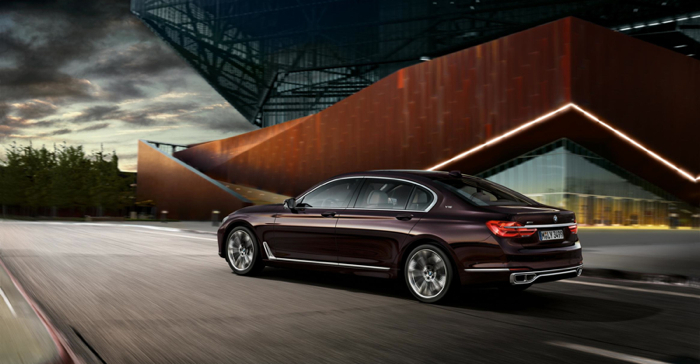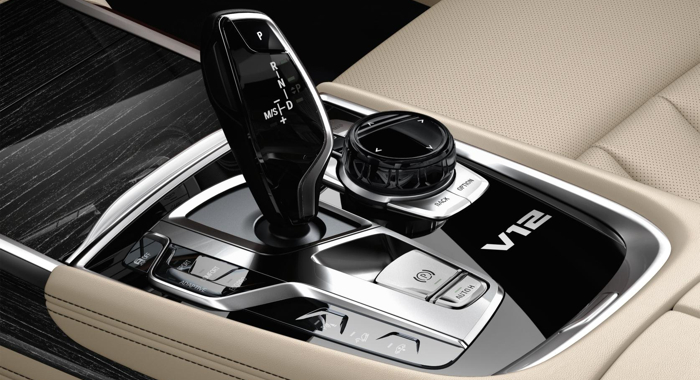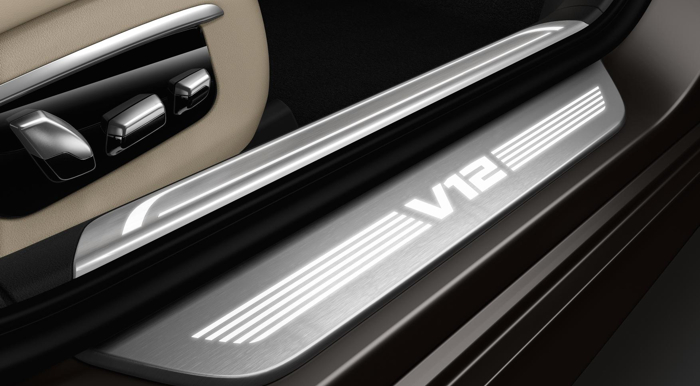
With TwinPower Turbo technology incorporated for the first time, this new M Performance engine produces 600 hp and 590 lb. ft. of torque. It’s harnessed by a highly sophisticated chassis specifically tailored to the model, and deployed to the road via BMW’s xDrive all-wheel-drive system with a rear-bias for more dynamic handling.
The 12-cylinder engine layout traditionally enjoys an exclusive status above all others, and in the new M760Li xDrive V12 provides a superb blend of performance and refinement. The 6,592 cc M Performance TwinPower Turbo 12-cylinder engine develops an output of 600 hp at 5,500 rpm and generates its peak torque of 590 lb. ft. from as low down as 1,500 rpm. This enables the car to accelerate from zero to 62mph in just 3.9 seconds and on to a governed top speed of 155 mph. It now also links up with the Auto Start-Stop function, which is just one measure that contributes to an impressive official combined fuel consumption figure of 22.4mpg.
For the construction of the all-aluminum block, BMW engineers focused on maximising rigidity while also minimizing weight. Using a closed-deck structure, combined with bolts holding the cylinder head down on the floor plate of the crankcase, has ensured the stability of the cylinder liners. Double bolts on the main bearings, with an additional connection to the side panels through threaded support bushes and bolts, reduce the influence of lateral forces from the crankdrive on the crankcase. Further components that serve to reduce vibrations and noise to an absolute minimum are iron-coated aluminum pistons; forged connecting rods assembled using the cracking process, and likewise, a forged crankshaft.
Two key features have elevated the performance and efficiency of the new V12 onto an even higher level: M Performance TwinPower Turbo technology and High Precision Injection. Together they enable sharp responses to even the slightest movement of the accelerator, a linear torque curve and exceptionally low fuel consumption and CO2 emissions for a car in this performance class.
Under an engine cover bearing “M Performance” lettering are two mono-scroll turbochargers, located – thanks to the small 60-degree cylinder angle – in a compact arrangement on the outside of the two rows of cylinders. Each turbocharger supplies six cylinders with compressed air. Their positioning allows for short, straight and therefore flow-efficient pipe connections between the exhaust system and the turbochargers. A sophisticated indirect intercooler, minimising the overall volume of air required and reducing lag, cools the air from each turbocharger. An additional water pump feeds the separate coolant circuit required for this purpose, whose air-to-water heat exchangers are positioned directly on the intake manifold.
The engine’s catalytic converters are equipped with advanced exhaust gas sensors and quickly reach their optimum operating temperature thanks to their positioning close to the engine, assisting the M760Li xDrive V12 in meeting the EU6c exhaust standard. In order to reduce backpressure, the M sports exhaust system features mostly straight pipes of the largest possible diameter. The evolution of the rear silencers and flap activation system allows everything from maximum refinement to a full-bodied 12-cylinder soundtrack.
The adoption of high precision fuel injection optimises the combustion process. Injectors positioned centrally in the cylinder head measure out the fuel precisely and spray it into the combustion chambers in finely atomized form and at up to 200-bar of pressure. The mixture cooling brought about by the directly injected fuel also allows a higher compression ratio than that achieved by a turbocharged engine with manifold injection.
The M Performance 12-cylinder engine also features, in customary BMW fashion, Double-VANOS continuously variable camshaft timing. This allows the engine to run under part loads with a high level of residual gas and reduced throttle losses, maximizing fuel efficiency. Double-VANOS also contributes to the engine’s rapid responses.
Another optimization with the new engine is the oil supply system. Its volume flow-controlled pump operates only when required and is therefore extremely efficient.
An eight-speed Steptronic Sport transmission is fitted as standard in the new M760Li xDrive V12. M Performance-specific tuning of the shift programs delivers sportier gear changes and more instantaneous downshifts throughout the rev range, Launch Control function is also included. The transmission can also be operated via the gearshift paddles on the steering wheel: in manual mode the transmission holds the selected gear even when the engine hits the rev limiter. At the same time, its compact construction, low weight, optimized efficiency and flawless interaction with the Auto Start-Stop function allows it to play a significant role in reducing fuel consumptions and emissions.
















